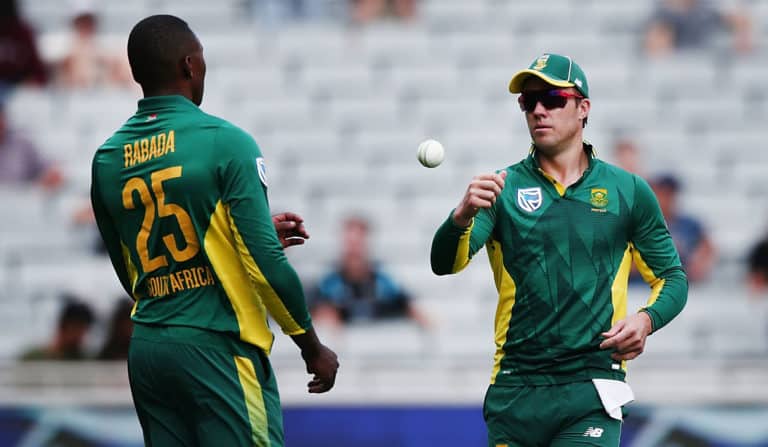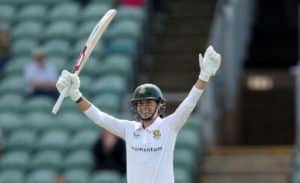The Proteas head into the Champions Trophy with only one competent death-bowling option in Kagiso Rabada.
How do South Africa go about addressing their death-bowling problems? The team appeared to provide a solution in the third ODI against England at Lord’s on Monday.
AB de Villiers won the toss and asked England to bat. Thereafter, Rabada and Wayne Parnell claimed six wickets between them in the space of five overs. England’s innings was done and dusted before the end of the 32nd over, and so South Africa weren’t required to bowl at the death.
Problem solved, right? A winning formula, right?
The Proteas have won 15 of their last 19 ODI matches. On six occasions – including the match at Lord’s – South Africa have dismissed the opposition inside 40 overs. On all six of those occasions, they have gone on to win.
PLAY OF THE DAY: Rabada’s fantastic four
That said, the chances are that the Proteas will be asked to perform in a 100-over humdinger sooner rather than later. Indeed, one would expect the upcoming Champions Trophy to serve up such contests more often than not, especially in the knockout stages.
Which brings us to the biggest question: are the Proteas prepared for such a challenge?
South Africa may bat deep, and they may possess some of the best finishers on the planet, but their death-bowling stocks are woefully thin. This much was evident when they leaked 102 runs in the last 10 overs at Headingley recently, and when they conceded 111 during the same period at the Rose Bowl.
Rabada is going to be a key player for the Proteas at the Champions Trophy. He should take heart from that four-wicket performance with the new ball at Lord’s. He should be confident of his ability with the old ball following a string of consistent showings over a period of 19 games.
Rabada has been De Villiers’s go-to man at the death of an innings. The statistics confirm that the 22-year-old has been used more than any other South African bowler at the death since the beginning of the 2016-17 season. Rabada has limited the opposition to 7.13 runs per over and has taken more wickets than any other South African bowler during this period.
So why do the Proteas have such a problem at the death when they possess an excellent death-bowling exponent in Rabada? Evidently, the other players in the attack don’t boast the same experience or ability to perform under pressure.
Imran Tahir has operated for one- or two-over spells during this period and has gone for 8.20 runs per over – which isn’t too bad given that batsmen usually target the slower bowlers at this time. Other death-bowling regulars like Chris Morris (8.75) and Andile Phehlukwayo (9.26) have been more expensive.
Those averages, however, represent the performances across South Africa’s last 19 matches. They include all the performances against Sri Lanka and Australia.
More should be read into the Proteas’ recent showings against New Zealand and England. South Africa were tested over the course of the five-game series in New Zealand, yet still managed to win 3-2. They went down 2-1 in the recent series in England.
The statistics across these six games make for interesting reading. The numbers confirm that Rabada has performed better in these high pressure games than in the ‘less competitive’ clashes which preceded them. Rabada averaged seven runs per over at the death, and took more wickets than any other South Africa bowler.
Meanwhile, the stats show how Morris (10.66) and Phehlukwayo (11.33) have been ineffective against the better batting lineups of New Zealand and England. Tahir (9.88) and another death-bowling regular in Parnell (9.80) have also come in for some punishment against the Kiwis and English. Dwaine Pretorius, who is still new to ODI cricket, has averaged eight runs per over across three one-over spells.
South Africa’s opponents batted deep in six of those eight matches. Across those games, the Proteas bowling attack went for an average of 9.86 runs per over (in the final 10 overs of the innings). The struggle to take wickets during this period was a big part of the problem. Rabada claimed three of South Africa’s seven death wickets across the matches against New Zealand and England.
Veteran bowler Dale Steyn has been ruled out of the Champions Trophy due to injury. The Proteas will certainly miss his contributions at the death. Prior to breaking down during the 2016-17 season, Steyn was thrown the ball at the death on three occasions. He took five wickets in total and went for just 7.41 runs per over.
Who will partner Rabada at the death when the game is taken deep in the coming weeks? Recent performances suggest that the Proteas have no quality alternatives. Perhaps De Villiers will ask his senior bowler, Morné Morkel to do a job in the latter overs. It would be a gamble, though, as Morkel has played just one ODI in the past 11 months.
The Proteas possess a formidable batting lineup, but batting alone won’t win them the Champions Trophy. As seen in the recent series against New Zealand and England, the extra 30 to 50 runs leaked by an inferior bowling unit at the death can influence the outcome of a match.
ALSO READ: Now for Proteas to get the selection right
Photo: Anthony Au-Yeung/Getty Images





